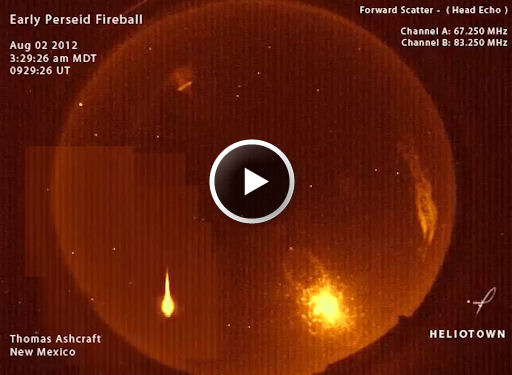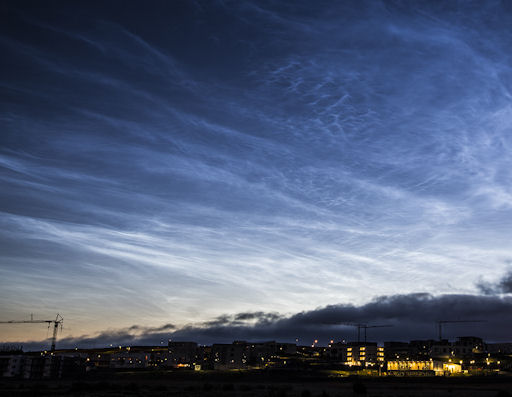CURIOSITY & SOLAR FLARES: Mars rover Curiosity has beeen hit by multiple solar flares en route to the Red Planet, giving NASA planners an idea of what faces human astronauts in the Earth-Mars expanse. [full story]
RIPPING PERSEID: As Earth enters a broad stream of debris from Comet Swift-Tuttle, more and more Perseid meteors are appearing in the night sky. "Last night, I captured a Perseid fireball ripping through the ionosphere over New Mexico," reports amateur astronomer Thomas Ashcraft. "It was traveling pretty fast - 133,000 miles per hour!" Click to see and hear the meteoroid disintegrate:
The movie's sound track comes from Ashcraft's dual-frequency meteor radar. It works like this: Radio signals from distant VHF transmitters bounce off the meteor's ion trail. Ashcraft's antennas can pick up those reflections, which sound like ghostly echoes in the loudspeaker of his VHF receiver.
At the moment, Perseid meteor rates are low--no more than about 10 per hour. In the days ahead, however, Earth will plunge deeper into the comet's debris stream, and meteor activity will increase accordingly. Forecasters expect the shower to peak on August 12-13 with as many as 100+ meteors per hour visible from dark-sky sites. Stay tuned for Perseids.
ELECTRIC-BLUE CLOUDS: A bank of electric-blue noctiluent clouds swept across Iceland on August 2nd, producing a vivid display of luminous ripples and tendrils over Reykjavik:
"These are the highest clouds in Earth's atmosphere, located at altitudes of around 76 to 85 kilometres," says photographer Iurie Belegurschi. "It was a beautiful display."
New data from NASA's AIM spacecraft prove that noctilucent clouds (NLCs) are seeded by space dust. The tiny ice crystals that NLCs are made of nucleate around "meteor smoke" wafting through the upper reaches of Earth's atmosphere. Not only do these clouds look alien, they really are alien. A new video from NASA explains the research.

![]()
Solar wind
speed: 441.6 km/sec
density: 1.7 protons/cm3
explanation | more data
Updated: Today at 1624 UT
![]()
X-ray Solar Flares
6-hr max: C1 1224 UT Aug03
24-hr: C2 0600 UT Aug03
explanation | more data
Updated: Today at: 1600 UT
![]()
![]()
![]()
Daily Sun: 03 Aug 12
![]()
![]()
The sun is peppered with spots, but none poses a threat for strong solar flares. Credit: SDO/HMI
![]()
![]()
![]()
Sunspot number: 126
What is the sunspot number?
Updated 03 Aug 2012
Spotless Days
Current Stretch: 0 days
2012 total: 0 days (0%)
2011 total: 2 days (<1%)
2010 total: 51 days (14%)
2009 total: 260 days (71%)
Since 2004: 821 days
Typical Solar Min: 486 days
Updated 03 Aug 2012
The Radio Sun
10.7 cm flux: 135 sfu
explanation | more data
Updated 03 Aug 2012
![]()
![]()
![]()
Current Auroral Oval:
![]()
Switch to: Europe, USA, New Zealand, Antarctica
Credit: NOAA/POES
![]()
![]()
![]()
Planetary K-index
Now: Kp= 2 quiet
24-hr max: Kp= 4 unsettled
explanation | more data
![]()
Interplanetary Mag. Field
Btotal: 3.4 nT
Bz: 0.9 nT north
explanation | more data
Updated: Today at 1626 UT
![]()
![]()
![]()
Coronal Holes: 03 Aug 12
![]()
![]()
There are no large coronal holes on the Earthside of the sun. Credit: SDO/AIA.






